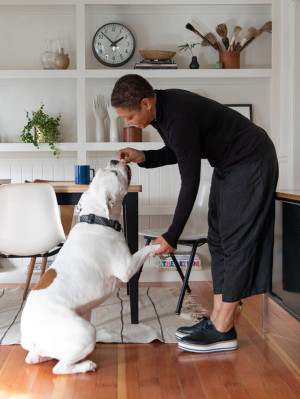How to Marie Kondo Your Pet’s Toy Collection
5 tips for decluttering dog and cat toys, according to KonMari certified consultants.

Share Article
Even if your pet’s toy collection had modest beginnings, chances are it’s quickly grown to contain stuffed animals in various states of disarray, strings and ropes of every size, and more tennis balls than you’d find courtside. Looking to take back control of your home while still keeping your dog or cat entertained? We asked two certified KonMari consultants (and loving pet parents) for their top tips on how to declutter piles of pet toys into a curated collection that’ll keep all your home’s inhabitants happy.
Step One: Place like with like and consider your vision.
An important early step in the KonMari Method is separating what you’re looking to declutter into categories, placing like with like. Michele Vig, the founder of Neat Little Nestopens in new tab and dog mom to Cavapoo, Piper, says that it will be “easier for you to pick out the toys you love and get rid of the ones you don’t when you have everything in one spot… You can see how much stuff you have and what you actually use.”

Save on the litter with color-changing tech that helps you better care for your cat.
Once you’ve grouped similar toys together, you can ask yourself the all-important question: Does this spark joy for me — and my pet? “The same way that people have favorite items that spark joy for them, your pet probably does too,” Jenny Albertiniopens in new tab, a professional organizer and mindfulness guide, explains.
As you go through your piles, you’ll also want to consider your vision for your space and how it should support you and your pet. For example, Albertini’s English Bulldog, Huck, loves to play with tennis balls. Instead of holding onto six tennis balls that will end up all over the place, Albertini will stick with one that’s easy to grab on the way to parks, walks, and other opportunities for play.
Step Two: Find the right container.
Once you’ve decluttered your collection a bit, the right storage container can help you whittle it down even more. Choose one that is modestly sized to keep toy accumulation in check. Once the bin is overflowing, it’s time to get rid of a few things. Albertini is partial to open, lightweight, soft bins that have low edges. Not only do these allow your pet to possibly access their own toys, but they also make cleanup a breeze: Just pick up the bin and throw stray toys back in it at the beginning or end of each day. She notes that reusing a bin you already own is preferable to buy a new one. The point of decluttering is to bring less stuff into your home, after all, and chances are the things in your space already fit your style.
Step Three: Put your bin in a central location.
Place your packed bin in a spot that’s easily accessible to your pet. If possible, Vig usually recommends placing toys in the same zone as all your other pet supplies, typically in or near the kitchen. “I often find that pet supplies are strewn throughout the house and it makes it hard for people to remember where things are,” she explains. Putting supplies like leashes, food, medicine, and toys together, near where feeding happens, will mean that everyone — including sitters and any younger kids helping with pet care — will always know where everything is.
This pet zone can be a mix of open containers for grab-and-go items like toys and leashes, and closed, airtight bins for fragrant food and treats. It can also hold a “backlog bin” for new toys you haven’t used yet, or toys that require supervision like horns and rawhide.
Step Four: Dispose of old toys responsibly.
Instead of throwing toys that didn’t make the cut into a big black bag and calling it a day, ask yourself if anything can be recycled or reused. If your pet only played with a new toy for a minute before deciding it wasn’t for them, call up a local pet shelter or secondhand store to see if they could use it. Vig notes that some food pantries will also gladly accept pet food and lightly used toys, so those can be another donation option. Be sure to wash toys first so they look good as new.
For soft toys that have seen a little more love, Albertini notes that you can bring them to a textile recycler to be responsibly disposed of (find one in your area hereopens in new tab), or incorporate them into DIY projects like pillows if you’re feeling crafty.
Step Five: Moving forward, buy less and buy better.
Wrapping up a decluttering project — especially when it’s for your favorite furry friend — can be super liberating. Keep the feeling going by vowing to be picky with your pet toys moving forward and only buying things you know that they’ll love and get a lot of use out of.
“Home resets are a really nice time to change your buying patterns, both for you and for your pets,” Albertini reminds us. Not only will this help minimize waste, it’ll save you the headache of cleaning up stray squeakers and fluff so you can focus on the important stuff: Playing with your pet!

Emma Loewe
Emma is a writer, editor, and environmentalist based in New York City. She is the senior sustainability editor at mindbodygreen, the author of Return To Nature: The New Science of How Natural Landscapes Restore Us (April 2022), and the co-author of The Spirit Almanac: A Modern Guide To Ancient Self-Care. While she doesn’t have any pets of her own, she is a loving dog aunt to Pip the pup.

